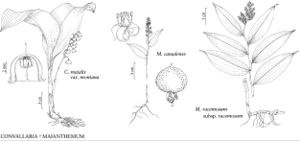Maianthemum canadense
Ann. Mus. Natl. Hist. Nat. 9: 54. 1807.
Plants terrestrial, 10–25 cm. Rhizomes sympodial, proliferatively branching, units 2–30 cm × 1–1.5 mm, roots restricted to nodes. Stems erect, 1–1.8 dm × 1–2.5 mm. Leaves solitary on sterile shoots, 2–3 on fertile shoots; blade 4.5–7 (–9) × 3–4.5 (–5.5) cm, apex acute or short-caudate; proximal leaves sessile, blade ovate, base with narrow sinus; distal leaves petiolate, blade cordate, petiole 1–7 mm. Inflorescences racemose, complex, 12–25-flowered. Flowers (1–) 2 (–3) per node, 2-merous; tepals conspicuous, 1.5–2 × 0.8–1 mm; filaments 1–1.5 mm; anthers 0.2–0.4 mm; ovary globose, 0.8–1 mm wide; style 0.5–0.8 mm; stigma distinctly 2-lobed; pedicel 3–7 × 0.2–0.5 mm. Berries green mottled red when young, maturing to deep translucent red, globose, 4–6 mm diam. Seeds 1–2, globose, 3 mm. 2n = 36, 54, 72.
Phenology: Flowering early spring.
Habitat: Deciduous and coniferous forests, persisting in forest remnants and parks
Elevation: 0–1800 m
Distribution

St. Pierre and Miquelon, Alta., B.C., Man., N.B., Nfld. and Labr., N.W.T., N.S., Ont., P.E.I., Que., Sask., Yukon, Conn., Del., D.C., Ga., Ill., Ind., Iowa, Ky., Maine, Md., Mass., Mich., Minn., Mont., Nebr., N.H., N.J., N.Y., N.C., N.Dak., Ohio, Pa., R.I., S.C., S.Dak., Tenn., Vt., Va., W.Va., Wis., Wyo.
Discussion
Pubescent specimens of Maianthemum canadense in the western half of the range with consistently larger leaves have been treated as var. interius.
Selected References
None.
Lower Taxa
"thicker" is not a number."dm" is not declared as a valid unit of measurement for this property.
